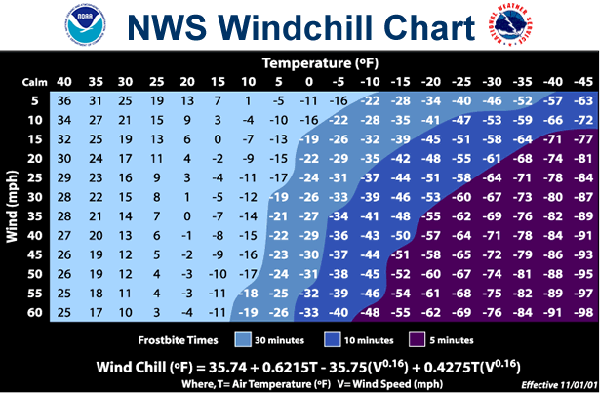Frostbite Awareness
Posted on February 6, 2014 by
With the weather systems hitting much of the United States with brutally cold temperatures this winter, it is good to be aware of the danger of frostbite. It can only take minutes for frostbite to set in on exposed skin. The onset of frostbite is a function of not only the current actual temperature, but of the wind chill temperature as well.
The National Weather Service provides a chart that correlates actual temperature to wind speed to calculate a wind chill temperature. The chart is color coded to demonstrate how quickly frostbite could set in for a given wind chill temperature.

Frostbite causes body tissue to freeze. If medical treatment is not administered immediately, the dead skin could lead to amputation of the affected area or death. Symptoms include a loss of feeling in extremities and a white or pale appearance. The affected area(s) should be SLOWLY re-warmed.
How to Avoid Frostbite
In addition to frostbite, extended exposure to cold temperatures and wind chill can cause hypotermia, which is a decrease in the body temperature. Hypothermia begins at body temperatures below 95 degrees Fahrenheit - normal body temperature is 98.6 degrees Fahrenheit, so you can see how little it takes. Warning signs include uncontrollable shivering, memory loss, disorientation, incoherence, slurred speech, drowsiness, and apparent exhaustion. Hypothermia also commonly creates the conflictory feeling of being too hot, which causes the victim to begin removing clothing. Obviously, this worsens their condition. Medical attention is required for hypothermia immediately. If not available, begin warming the body SLOWLY.
>>Visit the National Weather Service Wind Chill website, which has more information as well as a wind chill calculator in both Fahrenheit and Celcius scales.
The National Weather Service provides a chart that correlates actual temperature to wind speed to calculate a wind chill temperature. The chart is color coded to demonstrate how quickly frostbite could set in for a given wind chill temperature.

Frostbite causes body tissue to freeze. If medical treatment is not administered immediately, the dead skin could lead to amputation of the affected area or death. Symptoms include a loss of feeling in extremities and a white or pale appearance. The affected area(s) should be SLOWLY re-warmed.
How to Avoid Frostbite
- Obviously stay indoors when the wind chill is at frostbite potential temperatures
- Wear layers of loose-fitting, lightweight warm clothing
- Trapped air between clothing layers is a good insulator. Outer garments should be tightly woven, water repellent, and hooded.
- Cover extremities (fingers, toes, ear lobes, tip of the nose), as these areas are most susceptible to frostbite.
- Prevent loss of body heat by wearing a hat. As much as 40% of body heat can escape via the head.
- Cover your mouth to protect your lungs from extreme cold.
- Mittens, snug at the wrist, are better than gloves at protecting hands and fingers.
- Stay dry and out of the wind. Moderate physical activity to prevent sweating.
In addition to frostbite, extended exposure to cold temperatures and wind chill can cause hypotermia, which is a decrease in the body temperature. Hypothermia begins at body temperatures below 95 degrees Fahrenheit - normal body temperature is 98.6 degrees Fahrenheit, so you can see how little it takes. Warning signs include uncontrollable shivering, memory loss, disorientation, incoherence, slurred speech, drowsiness, and apparent exhaustion. Hypothermia also commonly creates the conflictory feeling of being too hot, which causes the victim to begin removing clothing. Obviously, this worsens their condition. Medical attention is required for hypothermia immediately. If not available, begin warming the body SLOWLY.
>>Visit the National Weather Service Wind Chill website, which has more information as well as a wind chill calculator in both Fahrenheit and Celcius scales.






